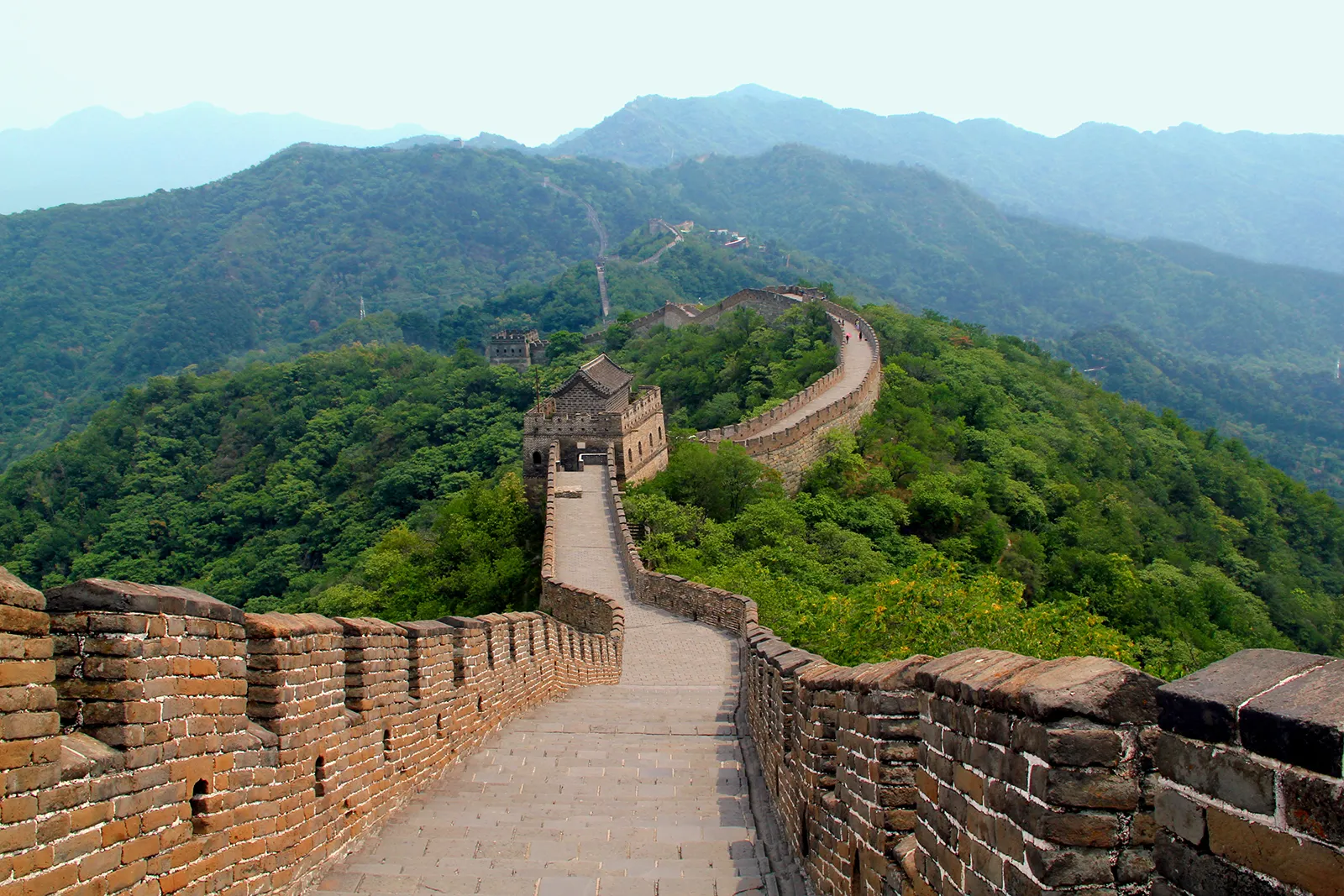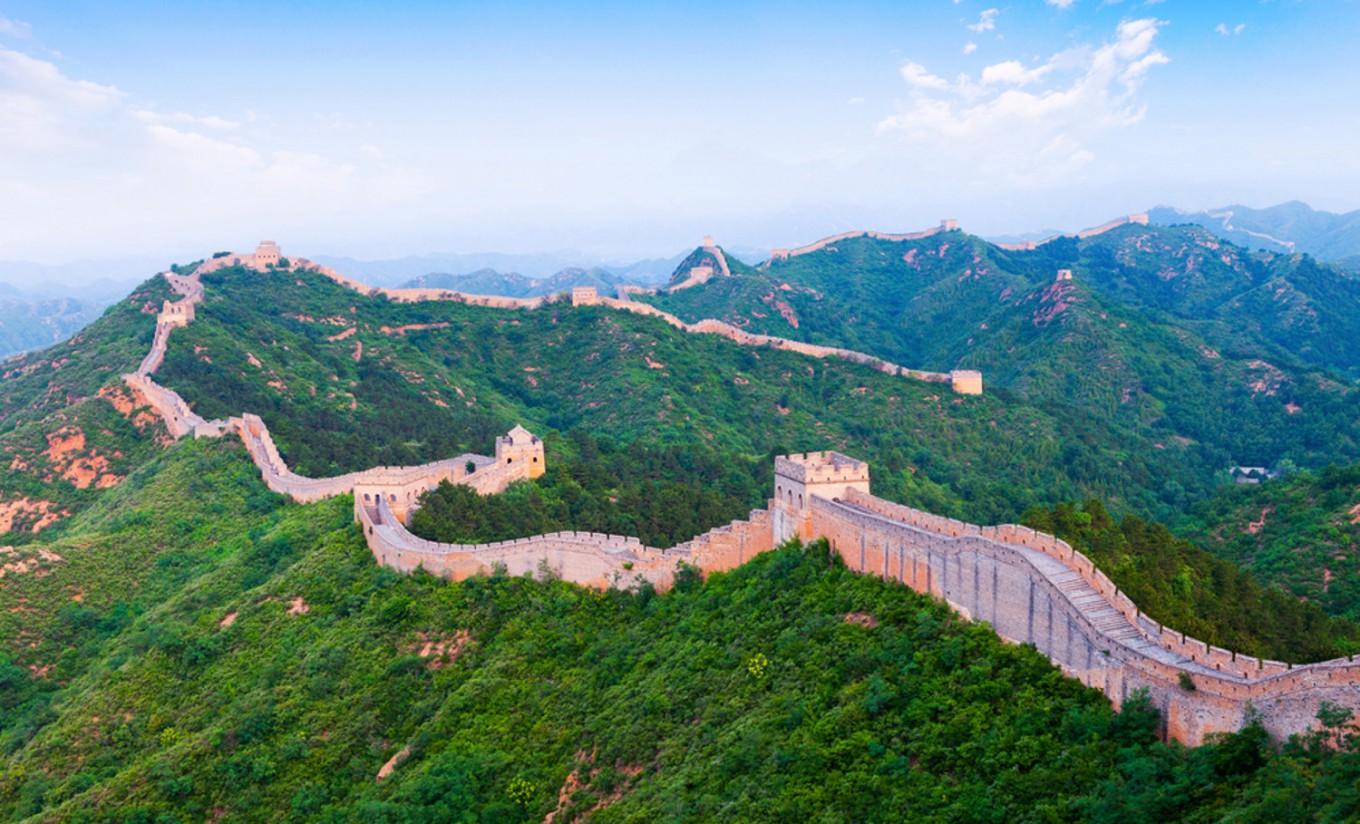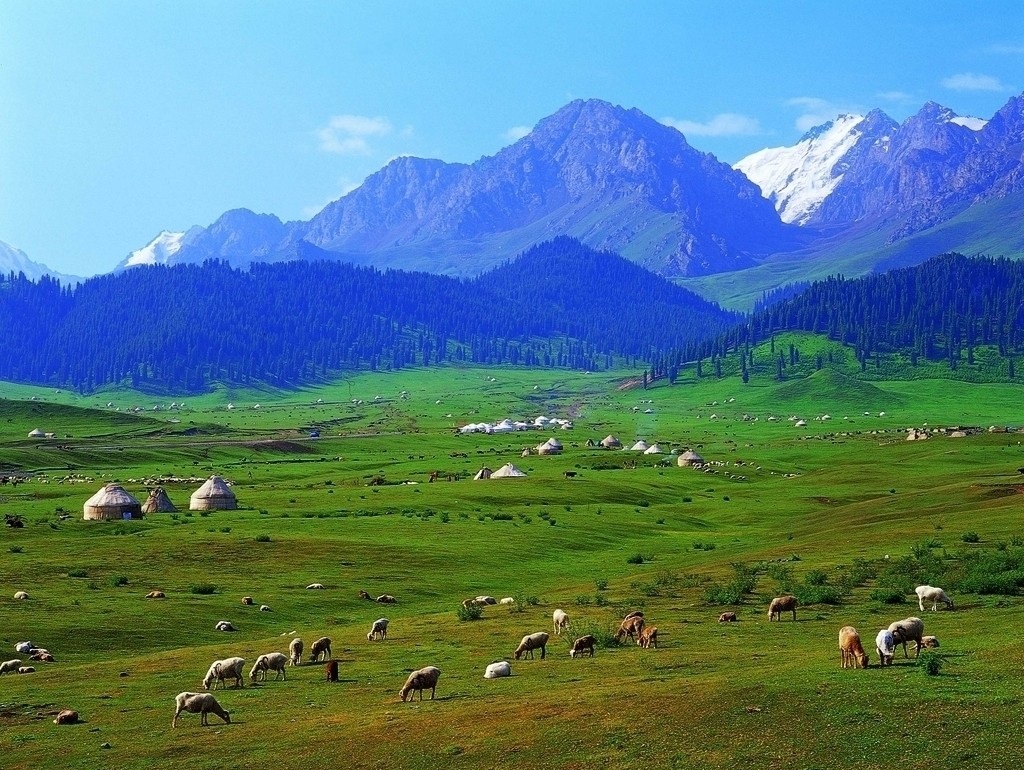
漢德百科全書 | 汉德百科全书
 新疆维吾尔自治区-新
新疆维吾尔自治区-新

Der Autonome Bezirk Changji der Hui-Nationalität (chinesisch 昌吉回族自治州) liegt im mittleren Norden des Uigurischen Autonomen Gebietes Xinjiang in der Volksrepublik China. Seine Hauptstadt ist Changji (昌吉市). Der Autonome Bezirk hat eine Fläche von 73.660,41 km² und ca. 1,57 Mio. Einwohner (Ende 2004).

 建筑艺术
建筑艺术
 北京市-京
北京市-京
 中国
中国
 长城
长城
 甘肃省-陇
甘肃省-陇
 河北省-冀
河北省-冀
 黑龙江省-黑
黑龙江省-黑
 河南省-豫
河南省-豫
 吉林省-吉
吉林省-吉
 辽宁省-辽
辽宁省-辽
 内蒙古自治区-内蒙古
内蒙古自治区-内蒙古
 宁夏回族自治区-宁
宁夏回族自治区-宁
 青海省-青
青海省-青
 陕西省-陕
陕西省-陕
 山东省-鲁
山东省-鲁
 陕西省-陕
陕西省-陕
 天津市-津
天津市-津

 假期和旅游
假期和旅游

 文化遗产
文化遗产
 新疆维吾尔自治区-新
新疆维吾尔自治区-新

 文明
文明






Die Chinesische Mauer, auch Große Mauer genannt, gilt als eines der größten bautechnischen Bravourstücke aller Zeiten.
Mit der Errichtung der ersten Abschnitte wurde unter Kaiser Qin Shi Huangdi im Jahre 220 v.Chr. begonnen. Die in einer 10 Jahre dauernden Bauzeit errichtete Mauer bestand anfangs nur aus Erdwällen, aufgeschichteten Felsbrocken und Palisadenwänden. Einige Teilabschnitte existierten bereits, errichtet von kleineren konkurrierenden Königreichen, und man erneuerte und verband diese unter Qin Shi Huangdis Herrschaft miteinander. Die Mauer war als Bollwerk gegen die kriegerischen mongolischen Nomaden aus dem Norden geplant und sollte auch die Macht und Herrlichkeit des Kaisers demonstrieren. Dafür beauftragte der Kaiser seinen erfolgreichsten General Meng-Tian mit dem Bau.
Von nun an wurde die Mauer wesentlich solider gebaut. Sie steht auf steinernen Fundamenten und ist mit Erde und Ziegeln errichtet. Nur die äußere Verkleidung besteht aus Bruchsteinen, die bis zu einem Meter dick ist, der Zwischenraum wurde mit Geröll, gestampfter Erde und anderen Materialien aufgefüllt. Von den Wachtürmen konnten in bis dato nie erreichter Geschwindigkeit Nachrichten mittels Flaggen, Rauchzeichen und nachts durch Feuer übermittelt werden. Ergänzt wurde das Grenz- sicherungssystem durch den Bau von Soldatenunterkünften und die Anlage befestigter Forts an strategisch wichtigen Stellen. Wenn Sie ihrer Länge nach besetzt war, war die militärische Bedeutung der Mauer enorm. Im Laufe der Jahrhunderte wurde sie dennoch vernachlässigt und verfiel allmählich.
Eine Legende besagt, daß Kaiser Qin Shi Huangdi von einem Magier weisgesagt wurde, die Mauer werde erst dann fertig sein, wenn "Wan" oder 10000 Menschen in ihr begraben sind. Nach langer Suche fand der Kaiser schließlich einen Mann namens Wan, ließ ihn töten und einmauern.
Die Chinesische Mauer ist eine Schutzanlage zur Grenzsicherung, die während der Ming-Dynastie (1368–1644) im Norden Chinas errichtet wurde.[1][2] Der chinesische Ausdruck ist 萬里長城 / 万里长城, Wànlǐ Chángchéng – „10.000-Li-Mauer, besser: zehntausende Li lange (Schutz-)Mauer“ oder kurz 長城 / 长城, Chángchéng, Jyutping Coeng4sing4anhören (kantonesisch)ⓘ/? – „Lange Mauer“, auch mit „Große Mauer“ (vgl. Englisch: „Great Wall“) übersetzt.
Die Anlage ist in Abschnitten zu unterschiedlichen Zeiten mit unterschiedlichen Bautechniken in der Ming-Dynastie gebaut worden.[3][4] Breite, begehbare Mauern im Norden Pekings aus der zweiten Hälfte des 16. Jahrhunderts bilden das ikonische Bild der Chinesischen Mauer und sind zu einem Sinnbild Chinas geworden. In anderen Abschnitten, besonders im Westen, ist die Befestigung oftmals aus festgeklopftem Lehm erbaut worden.[2] Die Länge der Schutzanlage wird mit 6260 Kilometern angegeben.[5]
1961年3月4日,长城被国务院公布为第一批全国重点文物保护单位 。1987年12月,长城被列入世界文化遗产。
长城(蒙古语:ᠴᠠᠭᠠᠨ
ᠬᠡᠷᠡᠮ,西里尔字母:Цагаан хэрэм;满语:ᡧᠠᠩᡤᡳᠶᠠᠨ
ᠵᠠᠰᡝ,穆麟德转写:šanggiyan jase),是中国古代为抵御不同时期塞北游牧帝国或部落联盟的侵袭,在西北方所修筑规模浩大的隔离墙或军事工程的统称。长城虽为城墙,但不做为完全单一条绝对隔离线,而是多层检查通行的边防口,实际上还主动发挥指导经贸交流的两手策略[1][2],东西段与前后关卡加总起来可绵延上万华里(约4500-6000千公尺),因此又称作万里长城。
现存的长城遗迹主要为始建于14世纪的明长城,西起嘉峪关,东至虎山长城,长城遗址跨越吉林、辽宁、北京、天津、山西、陕西、宁夏、甘肃等15个省市自治区,总计有43,721处长城遗产,长城也是自人类文明以来最巨大的建筑物。1961年起,一批长城重要点段被陆续公布为全国重点文物保护单位。1987年,长城被联合国教科文组织列为世界文化遗产,该遗产目前不仅包含上述15个省、市、自治区境内的长城,还额外包括了湖南和四川境内的苗疆长城(南长城)等[3]。
万里の長城(ばんりのちょうじょう、中国語: 万里长城、拼音: ワンリー ツァンツェン、モンゴル語: Цагаан хэрэм、ᠴᠠᠭᠠᠨ
ᠬᠡᠷᠡᠮ、満州語: ᡧᠠᠩᡤᡞᠶᠠᠨ
ᠵᠠᠰᡝ[1]、šanggiyan jase)は、中華人民共和国に存在する城壁の遺跡である。ユネスコの世界遺産(文化遺産)に登録されており、2007年には新・世界七不思議にも選ばれている[2]。中国には他にも長く連なった城壁、いわゆる長城は存在するが、万里の長城が規模的にも歴史的にも圧倒的に巨大なため、単に長城と言えば万里の長城のことを指す。現存する人工壁の延長は6,259.6kmである[3]。
匈奴のような北方の異民族が侵攻してくるのを迎撃するために、秦代の紀元前214年に始皇帝によって建設された。長城は始皇帝によって建設されたと一般には考えられているが、実際にはその後いくつかの王朝によって修築と移転が繰り返され、現存の「万里の長城」の大部分は明代に作られたものである。この現存する明代の長城線は秦代に比べて遥かに南へ後退している。
よく「農耕民族と遊牧民族の境界線」と言われるが、秦・漢代の長城は草原の中に建っているところが多い。これは両王朝が遊牧民族に対し優位に立ち、勢力圏を可能な限り北方へと広げようとしたためである。それに対し明代の長城は防衛を容易にするために中国本土に近いところに建設されており、とくに首都北京付近においてその傾向が強く、北京付近の長城は北京から100kmも離れていない稜線上に設けられている。万里の長城は南北両勢力の境界線として機能したが、北方の遊牧民族も南方の農耕民族もお互いの物産を必要としており、長城沿いには交易所がいくつも設けられ、盛んに取引が行われていた。交易はいつもうまくいっていたわけではなく、北方民族側の思うとおりにいかない場合もあった。その交易を有利にするための威嚇として、明の力が弱い時期に北方民族は長城を越えて侵入を繰り返していた。また、長城は観念上においても両勢力の境界線として機能し、たとえば中原の諸王朝が北方遊牧民族を指す場合、「塞外」(塞は城塞の意味で、この場合万里の長城を指す)という言葉が用いられることも多かった。
万里の長城は建設後常に維持・利用されていたわけではなく、積極的に長城を建設・維持する王朝と、まったく長城防衛を行わない王朝の2種が存在し、各王朝の防衛戦略によって長城の位置も大きく変動している。始皇帝による建設以後においては、秦・前漢・北魏・北斉・隋・金・明は大規模な長城建設を行ったのに対し、後漢・魏・晋・五胡十六国の諸王朝・唐・五代の各王朝・宋・元・清は長城防衛をほとんど、あるいはまったく行わなかった。長城の建設位置に関しても、秦・前漢・金は中原から遠く離れた草原地帯に長城を建設したのに対し、北魏・北斉・明は中原に近い山岳地帯を中心に長城を建設した。
なお、「宇宙から肉眼で見える唯一の建造物」と言われ、中華人民共和国の教科書にも掲載されていたが、実際には幅が細い上、周囲の色と区別が付きにくいため、視認することは出来ない。2003年に中国初の有人宇宙船「神舟5号」に搭乗した宇宙飛行士である楊利偉が、「万里の長城は見えなかった」と証言したため、中華人民共和国の教科書から、この節は正式に削除された[4]。2004年には、中国系アメリカ人の宇宙飛行士であるリロイ・チャオが、国際宇宙ステーション(ISS)より180ミリ望遠レンズを付けたデジタルカメラで「万里の長城」を写真撮影することに成功したが、肉眼では見えなかったと証言している[5]。
The Great Wall of China is a series of fortifications made of stone, brick, tamped earth, wood, and other materials, generally built along an east-to-west line across the historical northern borders of China to protect the Chinese states and empires against the raids and invasions of the various nomadic groups of the Eurasian Steppe with an eye to expansion. Several walls were being built as early as the 7th century BC;[2] these, later joined together and made bigger and stronger, are collectively referred to as the Great Wall.[3] Especially famous is the wall built in 220–206 BC by Qin Shi Huang, the first Emperor of China. Little of that wall remains. The Great Wall has been rebuilt, maintained, and enhanced over various dynasties; the majority of the existing wall is from the Ming Dynasty (1368–1644).
Apart from defense, other purposes of the Great Wall have included border controls, allowing the imposition of duties on goods transported along the Silk Road, regulation or encouragement of trade and the control of immigration and emigration. Furthermore, the defensive characteristics of the Great Wall were enhanced by the construction of watch towers, troop barracks, garrison stations, signaling capabilities through the means of smoke or fire, and the fact that the path of the Great Wall also served as a transportation corridor.
The frontier walls built by different dynasties have multiple courses. Collectively, they stretch from Dandong in the east to Lop Lake in the west, from present-day Sino-Russian border in the north to Qinghai in the south; along an arc that roughly delineates the edge of Mongolian steppe. A comprehensive archaeological survey, using advanced technologies, has concluded that the walls built by the Ming dynasty measure 8,850 km (5,500 mi).[4] This is made up of 6,259 km (3,889 mi) sections of actual wall, 359 km (223 mi) of trenches and 2,232 km (1,387 mi) of natural defensive barriers such as hills and rivers.[4] Another archaeological survey found that the entire wall with all of its branches measures out to be 21,196 km (13,171 mi).[5] Today, the Great Wall is generally recognized as one of the most impressive architectural feats in history.[6]
La Grande Muraille1 (chinois simplifié : 长城 ; chinois traditionnel : 長城 ; pinyin : ; Wade : Ch'ang²ch'eng² ; littéralement « la longue muraille »), aussi appelé « Les Grandes Murailles » est un ensemble de fortifications militaires chinoises construites, détruites et reconstruites en plusieurs fois et à plusieurs endroits entre le IIIe siècle av. J.-C. et le XVIIe siècle pour marquer et défendre la frontière nord de la Chine. C'est la structure architecturale la plus importante jamais construite par l’Homme à la fois en longueur, en surface et en masse.
Populairement, on désigne sous le nom de « Grande Muraille » la partie construite durant la dynastie Ming qui part de Shanhaiguan sur le territoire de la ville de Qinhuangdao dans la province du Hebei à l’est pour arriver à Jiayuguan dans la province du Gansu à l’ouest. Sa longueur varie selon les sources. Selon un rapport de 1990, la longueur totale des murs serait de 6 259,6 km2. En raison de sa longueur, elle est surnommée en chinois « La longue muraille de dix mille li » (chinois simplifié : 万里长城 ; chinois traditionnel : 萬里長城 ; pinyin : ; Wade : Wan⁴li³ Ch'ang²ch'eng²), le li étant une ancienne unité de longueur chinoise et dix mille symbolisant l’infini en chinois. Ce surnom peut cependant être pris dans son sens littéral par approximation, 6 700 km faisant 11 632 li dans sa valeur généralement considérée de 576 m ou 13 400 li dans sa valeur actuelle d’exactement 500 m. En moyenne, la muraille mesure 6 à 7 m de hauteur, et 4 à 5 m de largeur. En avril 2009, l'Administration d'État chargée du patrimoine culturel, ayant utilisé des technologies de mesure plus récentes3, révise cette mesure et déclare une longueur de 8 851,8 km dont 6 259,6 km de murs, 359,7 km de tranchées et 2 232,5 km de barrières naturelles, telles des montagnes ou des rivières. Le même service a publié en juin 2012 une mise à jour de son étude, et estime désormais à 21 196,18 km la longueur totale de la Grande Muraille4,5. Cette nouvelle estimation prend en compte des parties actuellement détruites.
Depuis 1987, la Grande Muraille est classée au patrimoine mondial de l'UNESCO sous le numéro 4386. En 2015, le constat est fait d'une nette dégradation de l'état général de la Grande Muraille due principalement aux conditions climatiques et aux activités humaines, et de la nécessité d'intervenir rapidement pour assurer sa sauvegarde7.
La Grande Muraglia (長城T, 长城S, ChángchéngP), nata come Wanli changcheng (萬里長城T, 万里长城S, Wànlǐ ChángchéngP, Grande muraglia di 10.000 Lǐ[1]), consiste in una lunghissima serie di mura situate nell'odierna Cina.
Costruita a partire dal 215 a.C. circa per volere dell'imperatore Qin Shi Huang (秦始皇S, Qín Shǐ HuángP, Ch'in Shih-huangW, letteralmente "Primo Imperatore della dinastia Qin") - lo stesso a cui si deve il cosiddetto Esercito di terracotta di Xi'an - la sua lunghezza è stata considerata, fino a poco tempo fa, di 6.350 chilometri con altezze variabili.
Dalle misurazioni effettuate nel 2009 con più recenti strumentazioni tecnologiche (raggi infrarossi, GPS), la Grande Muraglia risulterebbe lunga 8.850 chilometri, circa 2.500 in più di quelli stimati[2] (di cui circa 350 km di trincee e circa 2250 km di difese naturali).
È stata dichiarata dall'UNESCO patrimonio dell'umanità nel 1987 e inserita nel 2007 fra le sette meraviglie del mondo moderno.
La Gran Muralla (en el idioma original 长城, changcheng) es una antigua fortificación china construida y reconstruida entre el siglo V a. C. y el siglo XVI (Edad Moderna) para proteger la frontera norte del Imperio chino durante las sucesivas dinastías imperiales de los ataques de los nómadas xiongnu de Mongolia y Manchuria.
Contando sus ramificaciones y construcciones secundarias, se calcula que tiene sobre unos 21 200 kilómetros de largo,1 desde la frontera con Corea, al borde del río Yalu, hasta el desierto de Gobi, a lo largo de un arco que delinea aproximadamente el borde sur de Mongolia Interior, aunque hoy solo se conserva un 30 % de ella.2En promedio, mide de 6 a 7 metros de alto y de 4 a 5 metros de ancho.
La muralla fue designada Patrimonio de la Humanidad por la Unesco en 1987.3
El 26 de enero de 2007 se dio a conocer que la muralla china fue elegida como una de las ganadoras en la lista de Las Nuevas Siete Maravillas del Mundo Moderno.[cita requerida]
La Gran Muralla está hermanada con la muralla romana de Lugo, Galicia (España), también designada Patrimonio de la Humanidad.
Великая Китайская стена (кит. трад. 長城, упр. 长城, пиньинь: Chángchéng, буквально: «Длинная стена» или кит. трад. 萬里長城, упр. 万里长城, пиньинь: Wànlǐ Chángchéng, буквально: «Длинная стена в 10 000 ли») — разделительная стена длиной почти 9000 км (полная длина 21,2 тыс. км), построенная в древнем Китае. Крупнейший памятник архитектуры.
Проходит по северному Китаю на протяжении 8851,9 км[2][3], а на участке Бадалин проходит в непосредственной близости от Пекина (это длина последнего сооружения эпохи Минской династии, причём сюда входят 6259 км собственно стен, 359 км рвов, 2232 км естественных защитных рубежей в виде холмов и рек).
Длина стены со всеми ответвлениями составляет 21 196 километров[4].
Толщина Великой стены в основном около 5-8 метров, а высота чаще всего около 6-7 метров (на некоторых участках высота достигает 10 метров)[источник не указан 681 день].
Стена идёт вдоль горной цепи Иньшань, огибая все отроги, преодолевая как высокие подъёмы, так и весьма значительные ущелья.
На протяжении многих столетий, стена меняла названия. Изначально называлась «Барьером», «Разгулом» или «Крепостью», позднее стена обрела более поэтичные названия, такие, как «Пурпурная граница» и «Земля драконов». Только в конце XIX века она получила название, которое известно нам и по сей день.



Die Daur (auch: Dauren, Daguren, Daghuren, Dachuren u. a.; Eigenbezeichnung: Daor; chinesisch 達斡爾族 / 达斡尔族, Pinyin Dáwò’ěrzú; bis Anfang der 1950er Jahre zählten Teile von ihnen zu den "Solonen" chinesisch 索倫, Pinyin Suòlún),[1] sind eine der 56 offiziell anerkannten Nationalitäten der Volksrepublik China. Sie sprechen eine Sprache aus der mongolischen Sprachfamilie. Nach der letzten Volkszählung im Jahr 2010 zählen sie 131.992 Menschen. Sie leben in der Inneren Mongolei (Hulun Buir, vor allem Morin Dawa), in Heilongjiang (Qiqihar, vor allem Meilisi, Youyi und Taha), und in Xinjiang (Tacheng).[2]
达斡尔族是中国少数民族之一,主要分布于内蒙古自治区莫力达瓦达斡尔族自治旗、鄂温克族自治旗以及黑龙江省齐齐哈尔市梅里斯达斡尔族区一带;少数居住在新疆塔城。目前约有13.1万人。亦分布于俄罗斯(石勒喀河与伯力一带),俄罗斯称相关地区为达斡里亚(Даурия),即外贝加尔。
ダウール族(達斡爾族)は、モンゴル系の民族。中国領内の内モンゴル自治区北部のフルンボイル市、黒竜江省が元来の居住地であり、また清代の乾隆年間(18世紀後半)には新疆に駐屯兵が派遣され、その末裔数千人が旧駐屯地(現在のタルバガタイ地区)に分布している。人口は約13万2千人。
The Daur people (Khalkha Mongolian: Дагуур/Daguur; simplified Chinese: 达斡尔族; traditional Chinese: 達斡爾族; pinyin: Dáwò'ěr zú; the former name "Dahur" is considered derogatory[citation needed]) are a Mongolic-speaking ethnic group in northeastern China. The Daurian form one of the 56 ethnic groups officially recognised in the People's Republic of China. They numbered 131,992 according to the latest census (2010), and most of them live in Morin Dawa Daur Autonomous Banner in Hulun Buir, Inner Mongolia and Meilisi Daur District in Qiqihar, Heilongjiang of China. There are also some near Tacheng in Xinjiang, where their ancestors were moved during the Qing Dynasty.
Les Daur (chinois simplifié : 达斡尔族 ; chinois traditionnel : 達斡爾族 ; pinyin : ; l'ancien nom "Dahur" est considéré comme péjoratif[réf. nécessaire]) sont un groupe ethnique constituant un des 56 groupes ethniques officiellement identifiés par la République populaire de Chine.
I Daur (o anche Dahur, in Cinese: 达斡尔族, in Pinyin: Dáwò'ěrzú; il nome ufficiale "Dahur" è considerato dispregiativo) sono un gruppo etnico facente parte dei 56 gruppi etnici riconosciuti ufficialmente dalla Repubblica popolare cinese.
Secondo l'ultimo censimento del 2000, essi contano 132,394 individui, molti dei quali vivono sotto la Bandiera Autonoma dei Daur Morin Dawa (Mòlì Dáwǎ Dáwò'ěrzú Zìzhìqí 莫力达瓦达斡尔族自治旗), nella regione autonoma cinese detta "Mongolia Interna" (Nei Menggu). Geneticamente, i Daur sono discendenti dei Kitai, come hanno provato alcune recenti analisi del DNA[1].
Los daur (chino: 达斡尔族; pinyin: Dáwò'ěrzú) son una minoría étnica, una de las 56 oficialmente reconocidas por el gobierno de la República Popular China. Habitan principalmente en la región autónoma de Mongolia Interior y en las provincias de Heilongjiang y Xinjiang. Su población aproximada es de unas 13.000 personas.

高昌故城(维吾尔语:قوچۇ قەدىمىي شەھىرى)是公元前1世纪到公元14世纪吐鲁番盆地的第一大中心城镇,也是新疆留存最大的故城遗址。[网 1][网 2]城遗址位于新疆维吾尔自治区吐鲁番市高昌区三堡乡,即火焰山南麓木头沟河三角洲。
高昌故城最早公元前由西汉王朝屯田部队所建,历经高昌壁、高昌垒、高昌郡后,于公元五世纪重建为高昌国的国都;唐王朝时期,为高昌县治所;高昌回鹘时期恢复国都地位。14世纪故城毁于战火。废弃以后,高昌故城城址逐渐被开发为耕地,对遗址破坏严重,大部分地面建筑物荡然无存。[书 1]高昌故城遗址周长超过5千米,面积约20平方千米。现存外城、内城、宫城(可汗堡)内外三部分。保存较好的建筑包括西南佛寺、大佛寺、可汗堡等。存在壁画、文书、塑像等于7—13世纪在吐鲁番盆地传播的佛教、摩尼教、景教等宗教遗存。主要建筑工艺包括夯筑法、土坯砌筑法、开凿窑洞法等。
Die alte Stadt Gaochang (Uigurisch: قوچۇ قەدىمىي شەھىرى) war vom 1. Jahrhundert v. Chr. bis zum 14. Jahrhundert n. Chr. die erste zentrale Stadt des Turpan-Beckens und ist der größte erhaltene Standort einer alten Stadt in Xinjiang.

Gesar[1] ist ein epischer tibetischer König, dessen Heldentaten in von Barden vorgetragenen Gesängen, in ihrer Gesamtheit Gesar-Epos genannt, beschrieben werden. Dieses Epos gilt als der größte zentralasiatische Epenzyklus.
Dieses Korpus von Erzählungen enthält das Grundmotiv vom Kampf des guten tibetischen Herrschers Gesar, der als Mensch geboren wird, jedoch viele göttliche Fähigkeiten hat, gegen das Böse in der Welt. Gesars kriegerische und listenreiche Taten werden in ganz Zentralasien von Ladakh bis in die Mongolei, besonders aber in Osttibet, in Form von Gesängen tradiert, daher wird es meist Gesar-Epos genannt. Es existiert unter anderem in tibetischer, mongolischer (ᠭᠡᠰᠡᠷ
ᠬᠠᠭᠠᠨ ᠤ
ᠲᠤᠭᠤᠵᠢ, Гэсэрийн тууж) und türkischer Sprache. Die Vortragenden waren und sind z. T. noch spezielle Gesar-Barden, die teilweise Texte im Umfang dicker Bücher memorieren können.
Das Epos ist sehr umfangreich und nimmt seinen Anfang mit der Entstehung der Welt. Es wurde wahrscheinlich für eine Aufführung über mehrere Tage hinweg konzipiert.
格萨尔王传(藏语:གེ་སར་རྒྱལ་པོ་,威利:Ge-sar rgal-po,蒙古语:ᠭᠡᠰᠡᠷ
ᠬᠠᠭᠠᠨ),流行在西藏和中亚地区的著名史诗,目前在西藏、蒙古和土族中间尚有140位演唱艺人在说唱这部史诗。
格萨尔王传已经存在有一千多年,长达60万诗行,相当于印度史诗《摩诃婆罗多》3部长,《罗摩衍那》15部,是世界最长的史诗。讲述传说中的岭国国王格萨尔的故事,对藏传佛教影响很大。
格萨尔王传在目前有多达五十多种不同的版本,但仅中国大陆发行的藏文版本就已达到120册,分29章。而第一个印刷发行的版本是1716年,在北京发布的蒙古文版。
The Epic of King Gesar[a] (/ˈɡɛzər, ˈɡɛs-/), also spelled Geser (especially in Mongolian contexts) or Kesar (/ˈkɛzər, ˈkɛs-/), is an epic cycle, of Tibet and greater Central Asia, believed to date from the 12th century, that relates the heroic deeds of the culture hero Gesar,[1] the fearless lord of the legendary kingdom of Ling (Wylie: gling). It is recorded variously in poetry and prose, through oral poetry performance, [2] it is sung widely throughout Central Asia and North East of South Asia. Its classic version is to be found in central Tibet.[3] Some 100 bards of this epic (Wylie: sgrung, "tale")[4] are still active today in the Gesar belt of China.[5] Tibetan, Mongolian, Buryat, Balti, Ladakhi and Monguor singers maintain the oral tradition and the epic has attracted intense scholarly curiosity as one of the few oral epic traditions to survive as a performing art. Besides stories conserved by such Chinese minorities as the Bai, Naxi, the Pumi, Lisu, Yugur[6] and Salar,[7] versions of the epic are also recorded among the Balti of Baltistan, the Burusho people of Hunza and Gilgit[6] and the Kalmyk and Ladakhi peoples,[8][9] in Sikkim, Bhutan, Nepal, and among various Tibeto-Burmese, Turkic, and Tungus tribes.[10] The first printed version was a Mongolian text published in Beijing in 1716.[11]
The epic is composed of a very large body of versions, each with many variants, and is reputed by some to be the longest in the world.[4] Although there is no one definitive text, the Chinese compilation so far of just its Tibetan versions has filled some 120 volumes, more than one million verses,[4] divided into 29 "chapters".[12] Western calculations speak of more than 50 different books edited so far in China, India and Tibet.[4]
L'épopée du roi Guésar — dit aussi Gesar Khan ou Gesar de Ling — est le poème épique le plus célèbre des populations tibétaines1, et mongoles.
Elle comporterait plusieurs millions de vers, ce qui en ferait l'œuvre littéraire la plus longue actuellement connue dans le monde. Composée il y a plus de huit siècles à partir de récits beaucoup plus anciens, elle est encore interprétée de nos jours par plusieurs dizaines de bardes dans les régions de populations tibétaines et mongoles.
L'épopée est inscrite au Patrimoine culturel immatériel de l'humanité depuis 2009 par l'UNESCO2.
L’Epica di Re Gesar, anche scritto Geser (particolarmente in contesti mongoli) o Gesser o Kesar, è un ciclo epico, ritenuto risalire al XII secolo, che racconta le gesta dell'eroe culturale Gesar [1], impavido signore del leggendario regno di Ling. Composto in varie forme di poesia e prosa aventi come stile tipico di rappresentazione lo shuochang cinese[2] e cantato in molte zone dell'Asia centrale e del nord est dell'Asia meridionale, la sua versione classica è rintracciabile nel Tibet centrale.[3] Un centinaio di bardi di questa narrazione epica[4] sono tuttora attivi nella cosiddetta "cintura Gesar" della Cina[5]. La tradizione è mantenuta viva da centinaia di cantastorie tibetani, mongoli, buriati, balti, ladakhi e tu ovvero mongour, e l'epica ha suscitato viva curiosità da parte degli studiosi come una delle poche tradizioni orali epiche sopravvissute in forma di arte performativa. Oltre agli intrecci conservati da minoranze cinesi come i bai, i naxi, i pumi, i lisu, gli iuguri[6] e i salar[7], ulteriori versioni dell'epica si riscontrano anche in Pakistan — tra i balti del Baltistan e i burúšo di Hunza e Gilgit [8], oltre che presso calmucchi e ladakhi[9][10], in Sikkim, Bhutan, Nepal, tra svariate etnie tibeto-birmane, popolazioni di lingue turche e tribù tunguse[11]. La sua prima versione stampata è stato un testo mongolo pubblicato a Pechino nel 1716.[12]
L'epica si compone di un amplissimo corpus di versioni, ciascuna delle quali a sua volta con molte varianti, e secondo alcuni sarebbe la più lunga del mondo.[13] Sebbene non esista un testo definitivo, l'attuale compilazione cinese soltanto delle versioni tibetane ha riempito 120 volumi, più di un milione di versi[14] divisi in 29 "capitoli".[15] Secondo conteggi occidentali, più di 50 libri sarebbero a questo punto pubblicati in Cina, India e Tibet.[13]
El rey Guesar es una epopeya tibetana. Es el escrito más largo del mundo, y actualmente el texto épico más antiguo que conserva vitalidad, y que se sigue recitando y ampliando oralmente hasta hoy en día.
Гэсэ́р (монг. Гэсэр, бур. Абай Гэсэр, калм. Гэсэр-хан) — в мифологии монгольских народов и народов Тибета, контактировавших с сяньбийцами: ниспосланный небом культурный герой — Сын Неба, небесный всадник, бог войны (покровитель воинов) и царь-избранник (ср. мессия), очищающий землю от чудовищ — демонов-мангусов. Как первый человек, спустившийся с неба (точнее, вылупившийся из небесного «космического яйца»), Гэсэр восходит к добуддийской, бонской традиции. В некоторых монгольских версиях Цотон оказывается двойником Гэсэра, одним из его воплощений.
По сходству функций или внешнему облику Гэсэр близок ряду персонажей буддийского пантеона: например, как бог войны (тиб. Далха, монг. Дайсун-тэнгэри, калм. Дайчин-тэнгри — см. тэнгри) иногда отождествляется с Джамсараном; с конца XVI века с Гэсэром ассоциируется бог войны в китайской мифологии Гуань-ди.
Героическая поэма о «сыне неба» — Гэсэр-хане, подробно комментированная Г. Н. Потаниным, является, по словам бурят, лучшим руководством для ознакомления с шаманской мифологией[1].

Das Opferfest (arabisch عيد الأضحى, DMG ʿĪdu l-Aḍḥā) ist das höchste islamische Fest. Es wird zum Höhepunkt des Haddsch gefeiert, der Wallfahrt nach Mekka, welches jährlich am Zehnten des islamischen Monats Dhu l-hiddscha beginnt und vier Tage andauert. Aufgrund des islamischen Mondkalenders kann das Opferfest zu jeder Jahreszeit stattfinden, es verschiebt sich im Sonnenkalender rückwärts um meist elf Tage pro Jahr.
Mit dem 'Īd al-fitr, dem Fest des Fastenbrechens am Ende des Fastenmonats Ramadan, gehört es zu den bedeutendsten Festlichkeiten im Islamischen Jahreskreis.
 地理
地理

 音乐排行榜
音乐排行榜


 历史
历史


 乐器
乐器


 文学
文学
 节假日
节假日